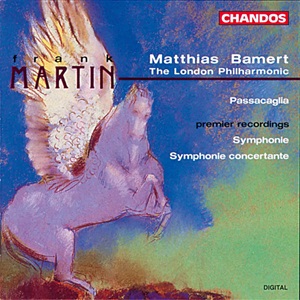
Frank Martin (1890-1974)
Symphonie for large orchestra (1937)
Symphonie Concertante for large orchestra (1945)
Passacaglia for large orchestra (1944)
London Philharmonic/Matthias Bamert
rec. 1993, Goldsmith’s College, New Cross, London
Presto CD
Chandos CHAN 9312 [67]
This welcome reissue of a CD first released in 1994 (review) deserves exposure, primarily because none of the works contained in the present format appear on disc elsewhere. All are major compositions of a composer whose relative neglect is still puzzling. Matthias Bamert and the London Philharmonic have done a real service here, as they have for Martin’s orchestral oeuvre in general.
The Symphonie is a big, four movement piece that has the typical sound of the composer. It is partly atonal and chromatic, but quite different from the second Viennese school’s twelve-tone serialism. Martin’s orchestration is rather opaque, alleviated by prominent roles for two pianos, vibraphone, xylophone, and saxophone. The texture of the first two movements is dark and dense, but relieved by the solo instruments, whether saxophone, flute, or clarinet. The third movement Scherzo livens things up with notable passages for woodwinds, percussion, and piano. It is actually in 4/4 rather than the 3/4 time usual for such movements. The Finale begins slowly with loud timpani and pianos. It is followed by a long piano cadenza marked ad libitum. The music quickens and becomes almost jazzy with saxophone and low brass before once again turning pensive and mysterious. It reminded me of Honegger’s symphonic writing. The work builds powerfully, climaxing on brass, percussion, and strings. It concludes on an emphatic note. Bamert and the orchestra clearly have the measure of this score, even if the recording had benefited from greater clarity.
The Symphonie Concertante is more familiar to record collectors in its original version as the Petite Symphonie Concertante for solo piano, harp, harpsichord, and strings which Martin composed for Paul Sacher. That version is special because of its solo instruments and clearer texture. It will likely remain the preference for this work. The much fuller orchestral version, however, has its own attractions with its woodwind, brass, and percussion parts. What the piece lacks in transparency, it partially compensates in the fuller orchestration and powerful ending. If the Symphonie Concertante does not replace the original version in one’s affections, it is nevertheless a good alternative. The work receives a fine performance on this recording.
The disc concludes with Martin’s orchestral transcription of his Passacaglia for organ. The obvious influence is Bach. The piece begins quietly in the lowest register of the orchestra, with the double basses playing the ground bass theme. With flute and oboe added, the music keeps building. An air of mystery predominates as bassoons are heard followed by brass and strings. This section reminded me of Shostakovich. After the ground bass is played loudly by the full orchestra, all settles down. The work ends quietly on a major chord—typical for Martin. The London Philharmonic and Bamert contribute impressive music making!
Presto is due a debt of gratitude for making this CD once again available, as it is the only game in town for this music.
Leslie Wright
Buying this recording via a link below generates revenue for MWI and helps us keep free access to the site


















